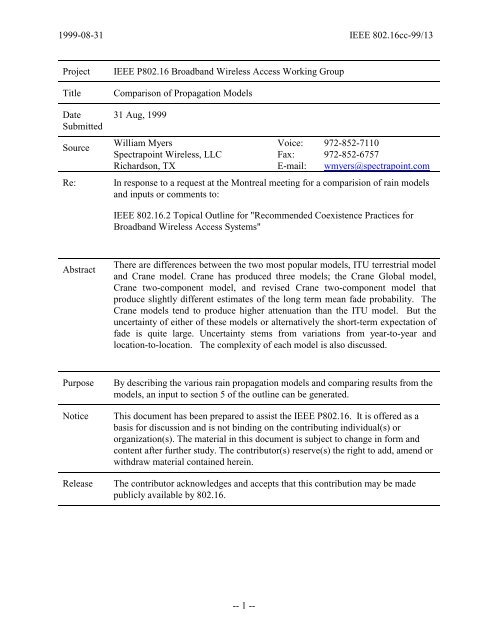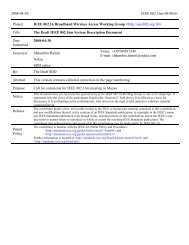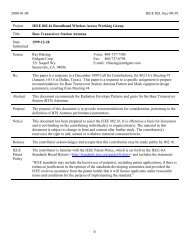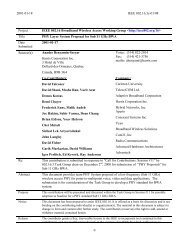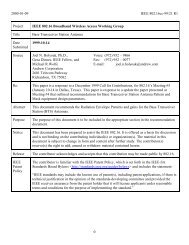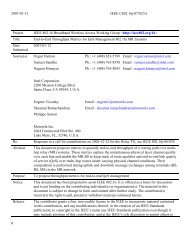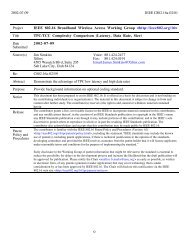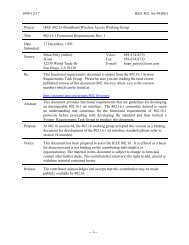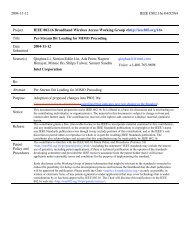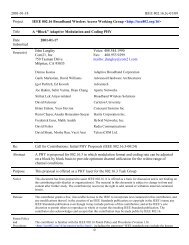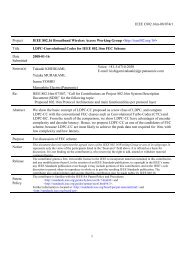Comparison of Propagation Models
Comparison of Propagation Models
Comparison of Propagation Models
You also want an ePaper? Increase the reach of your titles
YUMPU automatically turns print PDFs into web optimized ePapers that Google loves.
1999-08-31 IEEE 802.16cc-99/13ProjectTitleDateSubmittedSourceRe:IEEE P802.16 Broadband Wireless Access Working Group<strong>Comparison</strong> <strong>of</strong> <strong>Propagation</strong> <strong>Models</strong>31 Aug, 1999William MyersSpectrapoint Wireless, LLCRichardson, TXVoice: 972-852-7110Fax: 972-852-6757E-mail: wmyers@spectrapoint.comIn response to a request at the Montreal meeting for a comparision <strong>of</strong> rain modelsand inputs or comments to:IEEE 802.16.2 Topical Outline for "Recommended Coexistence Practices forBroadband Wireless Access Systems"AbstractThere are differences between the two most popular models, ITU terrestrial modeland Crane model. Crane has produced three models; the Crane Global model,Crane two-component model, and revised Crane two-component model thatproduce slightly different estimates <strong>of</strong> the long term mean fade probability. TheCrane models tend to produce higher attenuation than the ITU model. But theuncertainty <strong>of</strong> either <strong>of</strong> these models or alternatively the short-term expectation <strong>of</strong>fade is quite large. Uncertainty stems from variations from year-to-year andlocation-to-location. The complexity <strong>of</strong> each model is also discussed.PurposeNoticeReleaseBy describing the various rain propagation models and comparing results from themodels, an input to section 5 <strong>of</strong> the outline can be generated.This document has been prepared to assist the IEEE P802.16. It is <strong>of</strong>fered as abasis for discussion and is not binding on the contributing individual(s) ororganization(s). The material in this document is subject to change in form andcontent after further study. The contributor(s) reserve(s) the right to add, amend orwithdraw material contained herein.The contributor acknowledges and accepts that this contribution may be madepublicly available by 802.16.-- 1 --
1999-09-10 IEEE 802.16cc-99/13At millimeter wave, rain fading is the most dominant factor. Attenuation occurs due toabsorption and scattering in rain. Fading due to rain attenuation is described empirically fromlink tests and point rainfall data. Location variation is based on selected point rainfall data andradar reflectivity data accumulated around the world. Because raindrops are oblate rather thanspherical, attenuation tends to be greater for horizontally polarized signals than for verticalpolarized signals.The ITU has recommended a calculation method for terrestrial systems, ITU-R P.530, and forspace to earth links, ITU-R P.618 [7]. These models take into account a distance reduction factorto account for the cellular nature <strong>of</strong> storms and have improved since the original CCIR version.The “Crane” models, after Robert K. Crane, are popular for space-earth links but also haveterrestrial models. There are 3 versions <strong>of</strong> the Crane models. The Global Crane model wasdeveloped in 1980. In 1982 the 2-component Crane model was developed that used a pathintegratedtechnique. A volume cell contribution and a debris contribution for a path werecomputed separately and added to provide a link calculation. As a refinement <strong>of</strong> the 2-component model, the revised two-component model was introduced in 1989 which includesspatial correlation and statistical variations <strong>of</strong> rain within a cell. All <strong>of</strong> these are included inCrane’s book.III.Attenuation <strong>Comparison</strong> <strong>of</strong> MethodsCalculation by the ITU model is straightforward by scaling the .01% rain rate and by using aneffective path length reduction factor to account for the cellular nature <strong>of</strong> heavy rainfall. Meancumulative distributions <strong>of</strong> rainfall zones are defined geographically in ITU-R 837 [8].The Crane rainfall zones are defined differently than the ITU zones with more defined zones inthe US than the ITU zones.The following comparison <strong>of</strong> predicted attenuation is provided for places where the ITU andCrane zones overlap. ITU zone M does not correspond to a Crane zone very well and is notincluded in the comparison. Crane D2 and E are irregular through M, with Crane E extendingfrom Florida to Northern Alabama and up to South Carolina. Listed in the table are attenuationvalues for the same locations using the ITU zone for ITU calculations and the correspondingCrane zone for Crane calculations. All <strong>of</strong> the Crane models predict a larger attenuation than theITU model, however this difference is also about the same as the difference between variousCrane models.Table 1 Rain Attenuation <strong>Comparison</strong> at 99.99% Availability for 3 km PathITU Zone/Crane Zone Units E/F D/C K/D2 N/ERain Rate ITU/Crane mm/hr 22/22 19/29 42/47 95/91ITU-R 530 dB 10.8 14.3 22.3 39.2Crane Global dB 13.2 17.2 25.7 45.9Crane 2-component dB 13.6 18.4 28.8 52.0Crane revised T-C dB 12.4 20.0 26.9 51.3-- 3 --
1999-09-10 IEEE 802.16cc-99/13It is interesting that ITU zone D is Northern California with less rainfall and E is SouthernCalifornia with more rainfall. The corresponding Crane zones are C for Northern California andF for Southern California that predict just the opposite intensity.Table 2 shows a comparison <strong>of</strong> attenuation for the same location (ITU K and Crane D2) atdifferent availability values for a 3 km path.Table 2 Attenuation exceeded (1- Avail)% <strong>of</strong> the time <strong>Comparison</strong> for DifferentLink AvailabilitiesUnits 99.999% 99.99% 99.9%ITU-R 530 dB 47.8 22.3 8.5Crane Global dB 55.3 25.7 9.4Crane 2-component dB 75.7 28.8 9.3Crane revised T-C dB 68.7 26.9 9.0Data presented by Yamada [9] compares the results <strong>of</strong> the earlier CCIR model with the CraneGlobal and two-component models along with models by Morita [10], Lin [11] and others. TheCrane and other models were believed to overestimate the attenuation compared to the CCIRmodel. Yamada used 124 data sites and proposed changes to the CCIR model that arerepresented in the present ITU model. After improvement to the CCIR method, errors in themean attenuation were less than 20% at availabilities <strong>of</strong> 99.9% or better.Rain loss for ITU rain zones is shown in Figure 1 for path lengths up to 5 km and for anavailability <strong>of</strong> 0.9999. Capabilities are shown in dotted lines for an example QPSK system withEIRP density values <strong>of</strong> the US FCC EIRP limit, Canadian limit, and a typical system having 0dBW/MHz EIRP. An EIRP density <strong>of</strong> 0 dBW/MHz is within today’s technology and providesfade margin from 20 – 30 dB. With a subscriber antenna gain <strong>of</strong> 35 dBi, this would support linksup to 5 km in some rain zones.-- 4 --
1999-09-10 IEEE 802.16cc-99/13Loss (dB) exceeded 0.01 percent <strong>of</strong> time8070605040302010Clear Sky Margin - . -EIRP (dBW/MHz)0 (Typical)30 (US Limit)8 (Canada Limit)00 1 2 3 4 5Range (Km)Rain ZoneFigure 1 Rain Loss for ITU Rain Zones at 0.9999 Availability(or 0.01% Un-availability)PNMKFEIVVariability in ResultsYear to year and location to location variations occur from the predicted mean attenuation. BothCrane and Yamada have calculated the standard deviation <strong>of</strong> the predictions. Yamada foundattenuation standard deviation as high as 64% and Crane as high as 48% in the sample casesstudied. Crane determined that the distribution <strong>of</strong> deviations was lognormal and presents amodel for variability in terms <strong>of</strong> risk. Standard deviation <strong>of</strong> the natural logarithm <strong>of</strong> rain-rate,S m , was obtained as follows:Year-to-year, S m = 0.21Location-to-location, S m = 0.17Combined year-to-year and location-to-location, S m = 0.28The year-to-year standard deviation corresponds to 23% in dB and the combined standarddeviation corresponds to 32% in dB. A risk model [12] is presented by Crane to estimate theattenuation for any year over a selected number <strong>of</strong> years using the variability standard deviation.VComplexity <strong>of</strong> <strong>Models</strong>For prediction <strong>of</strong> rain fade attenuation using the ITU 530 standard, rain rate at the 0.01%exceeded level for the zone <strong>of</strong> interest is required, frequency, path length, frequency, and-- 5 --
1999-09-10 IEEE 802.16cc-99/13attenuation factors from ITU-R 838 [13]. Other percentages are calculated using only the 0.01%value. The ITU model consists <strong>of</strong> simple equations and know for ease <strong>of</strong> use.The Crane Global model requires solution <strong>of</strong> about 8 equations to obtain the path-averaged rainrate and a piecewise representation <strong>of</strong> the path pr<strong>of</strong>ile by exponential functions.The initial two-component Crane model first computes the volume cell contribution from thepath integrated rain rate produced by a volume cell and the debris contribution based on thelength scale for the debris path. About 10 equations are involved.For the revised two-component Crane model, spacial correlation functions are included and anintegral equation for the debris path. It also includes a prediction for satellite path diversity.Because <strong>of</strong> the complexity <strong>of</strong> the two-component models, attenuations in the above tables wereobtained from the program disk included with the book.VISummaryIn 1987, Yamada compared eight different models including 2 CCIR models using radiometermeasurements and satellite measurements. His conclusion was that the CCIR model for meanattenuation was the most accurate overall. The Crane two-component model was very close toexperimental results for probabilities around 0.1 to 1%. Although 124 test data points were usedin Yamada’s evaluation, however most were for about 1-year duration. Crane makes similarcomparisons from other data and concludes that his model is more accurate.I recommend that ITU 530 model should be used for terrestial links. The model is simple tocompute, and it is not clear that one model is more accurate than the other particularly at highrain rates. ITU 530 is an ITU recommendation that is the consensus among a group <strong>of</strong>international experts on the best method to estimate fade events.References[1] ITU-R P.530; <strong>Propagation</strong> Data and Prediction Methods Required for the Design <strong>of</strong>Terrestrial Line-<strong>of</strong>-Sight Systems[2] Crane, R. K. (1980); “Prediction <strong>of</strong> Attenuation by Rain, IEEE Trans. Commun., COM-28[3] Crane, R. K. (1982); “A Two-Component Rain Model for the Prediction <strong>of</strong> AttenuationStatistics”, Radio Sci. 20[4] Crane, R. K. and Shieh, Horng-Chung (1989), “ A Two-Component for the Prediction <strong>of</strong> SiteDiversity Performance”, Radio Sci. 24[5] Crane, R. K. (1996), Electromagnetic Wave <strong>Propagation</strong> Through Rain, Wiley[6] ITU-R P.453; The Radio Refractive Index: Its Formula and Refractivity Data[7] ITU-R P.618; <strong>Propagation</strong> Data and Prediction Methods Required for the Design <strong>of</strong> Earth-Space Telecommunications Systems[8] ITU-R PN.837 “Characteristics <strong>of</strong> Precipitation for <strong>Propagation</strong> Modelling”[9] Yamada, M., Karasawa, Y., and Yasunaga, M. (1987); “ An improved prediction method forrain attenuation in satellite communications operating at 10-20 GHz”, Radio Sci. 22-- 6 --
1999-09-10 IEEE 802.16cc-99/13[10] Morita, K. (1980); “Estimation methods for propagation characteristics on earth-to-spacelinks in microwave and millimeter wavebands”, Rev ECL NTT Jpn., 28[11] Lin, S. H. (1979); “Empirical rain attenuation model for earth-to-space paths”, IEEE Trans.Commun., COM-27[12] Crane, R. K. (1993); “Estimating Risk for Earth-Satellite Attenuation Prediction”, Proc.IEEE 81, No. 6.-- 7 --


